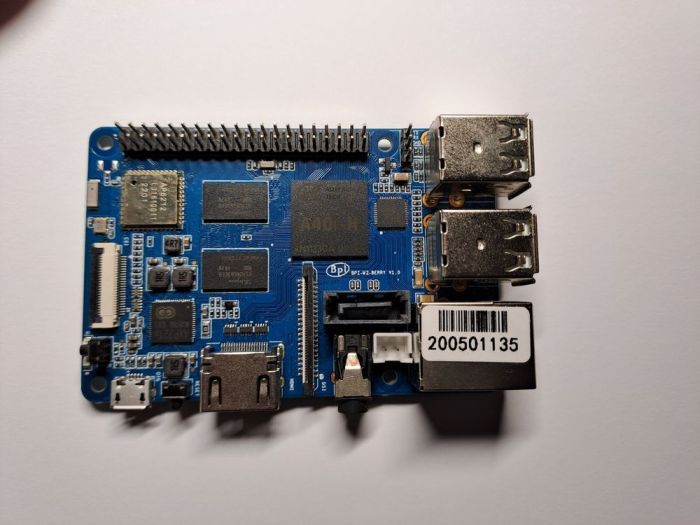Banana Pi vs. Other SBCs
The world of single-board computers (SBCs) is filled with a diverse range of options, each catering to different needs and applications. Banana Pi stands as a prominent contender in this space, offering a compelling alternative to other popular SBCs like Raspberry Pi, Orange Pi, and Arduino. This comparison delves into the strengths and weaknesses of Banana Pi, analyzing its target audience and use cases, and highlighting the key differences in functionalities compared to its competitors.
Comparison with Other SBCs
Banana Pi, Raspberry Pi, Orange Pi, and Arduino represent distinct categories within the SBC landscape, each with its unique features and target applications.
- Banana Pi: Known for its powerful hardware, versatility, and competitive pricing. It excels in demanding applications like embedded systems, industrial automation, and media streaming.
- Raspberry Pi: The most popular SBC, known for its accessibility, strong community support, and wide range of peripherals. It is widely used in educational settings, hobbyist projects, and home automation.
- Orange Pi: Offers a balance of performance and affordability, making it suitable for various applications like media playback, robotics, and home automation.
- Arduino: Primarily used for rapid prototyping and educational purposes, it focuses on ease of use and simplicity. It is ideal for beginners and projects involving sensor interaction and basic control.
Strengths and Weaknesses of Banana Pi
Banana Pi boasts several strengths that make it a compelling choice for specific applications.
- Powerful Hardware: Banana Pi models often feature more powerful processors and more RAM compared to Raspberry Pi and Orange Pi, enabling them to handle demanding tasks like video editing, gaming, and industrial applications.
- Versatility: Banana Pi boards support a wide range of operating systems, including Linux distributions, Android, and even Windows. This flexibility allows users to choose the OS that best suits their needs.
- Competitive Pricing: Banana Pi boards are generally priced more competitively than Raspberry Pi, offering a higher value proposition for users seeking powerful hardware at an affordable price.
- Community Support: While not as extensive as the Raspberry Pi community, Banana Pi enjoys a growing and active community, providing support and resources for users.
However, Banana Pi also has some weaknesses:
- Limited Peripheral Support: Compared to Raspberry Pi, Banana Pi has a smaller selection of readily available peripherals, requiring users to explore alternative options or rely on custom solutions.
- Documentation and Tutorials: While improving, the documentation and tutorials for Banana Pi are not as comprehensive as those for Raspberry Pi, making it more challenging for beginners to get started.
- Software Compatibility: Some software and applications may not be fully compatible with Banana Pi due to its unique hardware architecture, requiring users to find workarounds or rely on alternative solutions.
Target Audience and Use Cases
Banana Pi is primarily targeted towards:
- Hobbyists and Makers: Seeking powerful and versatile SBCs for advanced projects, such as robotics, home automation, and multimedia applications.
- Developers and Engineers: Working on embedded systems, industrial automation, and other demanding applications that require high performance and customization.
- Students and Educators: Exploring advanced computing concepts and building complex projects in educational settings.
Banana Pi is particularly well-suited for:
- Industrial Automation: Its powerful hardware and versatility make it ideal for controlling industrial machinery, monitoring sensors, and implementing automation solutions.
- Media Streaming and Playback: Banana Pi boards can handle high-resolution video playback and streaming, making them suitable for home theater systems and digital signage applications.
- Robotics and Artificial Intelligence: Banana Pi’s processing power and support for various operating systems make it suitable for developing and deploying robotic applications and AI algorithms.
Key Differences in Functionalities
Each SBC caters to a different set of needs, with key differences in their functionalities:
| Feature | Banana Pi | Raspberry Pi | Orange Pi | Arduino |
|---|---|---|---|---|
| Processor | Powerful, often quad-core or octa-core | Typically ARM-based, with varying processing power | Offers a range of processors, from single-core to quad-core | Microcontroller-based, designed for simple tasks |
| RAM | Larger RAM capacity, typically 1GB or more | Typically 1GB or 2GB RAM | Offers various RAM options, from 512MB to 2GB | Limited RAM, usually less than 1KB |
| Operating System | Supports Linux distributions, Android, and Windows | Primarily runs on Linux distributions, with some support for Android | Supports various Linux distributions and Android | Runs on its own proprietary programming language |
| Peripherals | Limited peripheral support compared to Raspberry Pi | Wide range of peripherals available, including cameras, displays, and sensors | Offers a moderate range of peripherals | Limited peripherals, primarily focused on sensor interaction and basic control |
| Community Support | Growing and active community, but smaller than Raspberry Pi | Large and active community, providing extensive resources and support | Smaller community, but growing | Vast and active community, with extensive resources and tutorials |
Whether you’re a seasoned developer looking for a powerful and flexible SBC or a curious beginner exploring the world of embedded computing, Banana Pi has something to offer. With its diverse model lineup, robust software support, and active community, Banana Pi stands as a testament to the power and potential of open-source hardware, empowering individuals to bring their ideas to life and push the boundaries of what’s possible.
The Banana Pi, a powerful single-board computer, has been a favorite among makers and hobbyists for its versatility and affordability. While it may not be getting official Android updates like the Nexus 7 2013 LTE receiving Android 5.1 , its open-source nature allows for custom ROMs and endless possibilities. The Banana Pi’s community thrives on innovation, ensuring its relevance in the ever-evolving world of technology.
 Standi Techno News
Standi Techno News
